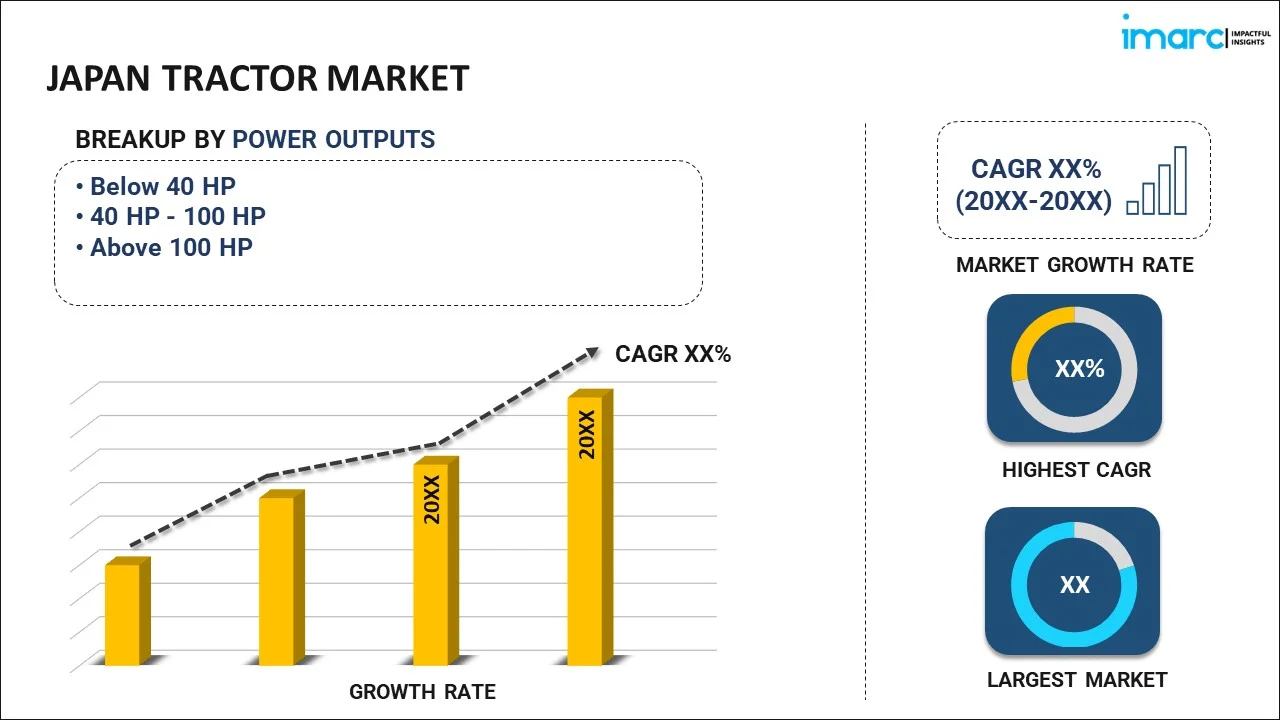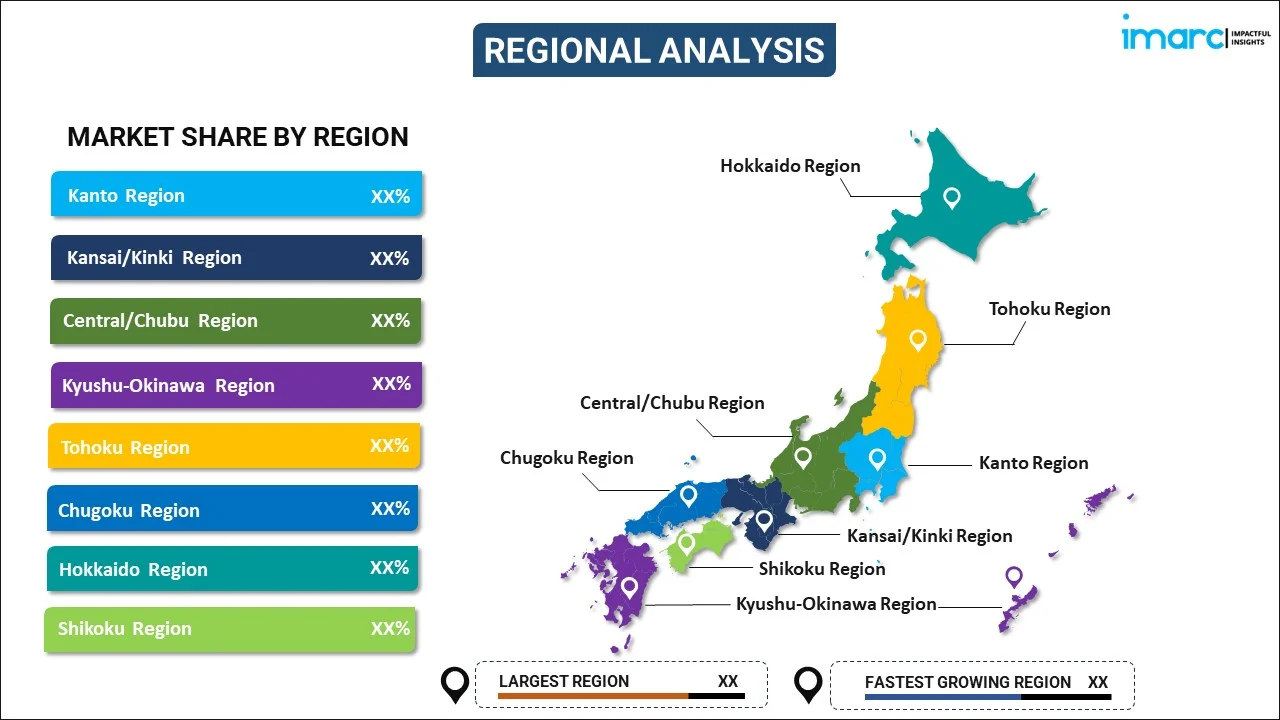
Japan Tractor Market Report by Power Output (Below 40 HP, 40 HP - 100 HP, Above 100 HP), Drive Type (2-Wheel Drive, 4-Wheel Drive), Application (Agriculture, Construction, Mining, Forestry, and Others), and Region 2025-2033
Market Overview:
Japan tractor market size reached USD 4,997 Million in 2024. Looking forward, IMARC Group expects the market to reach USD 6,723 Million by 2033, exhibiting a growth rate (CAGR) of 3.4% during 2025-2033. The advances in tractor technology, including improvements in fuel efficiency, automation, GPS guidance systems, and precision farming, that can boost productivity and reduce operating costs, are primarily driving the market.
|
Report Attribute
|
Key Statistics
|
|---|---|
|
Base Year
|
2024
|
|
Forecast Years
|
2025-2033
|
|
Historical Years
|
2019-2024
|
|
Market Size in 2024
|
USD 4,997 Million |
|
Market Forecast in 2033
|
USD 6,723 Million |
| Market Growth Rate 2025-2033 | 3.4% |
A tractor is a versatile and essential agricultural vehicle that has revolutionized modern farming practices. It is a powerful machine designed to perform various tasks on the farm, making it an indispensable tool for farmers. Tractors are typically equipped with large, robust tires that provide stability and traction on uneven terrain, enabling them to operate efficiently in fields and on rugged landscapes. One of the primary functions of a tractor is to provide the necessary power for tasks such as plowing, planting, cultivating, and harvesting crops. Its ability to tow and operate various attachments, such as plows, seeders, and harvesters, allows farmers to complete these tasks with ease and precision. Tractors come in a range of sizes and configurations, from compact models for small-scale farming to massive, high-horsepower machines for large agricultural operations. Beyond agriculture, tractors have found applications in the construction, landscaping, and transportation industries. Their adaptability and versatility have made them an integral part of modern life, playing a crucial role in ensuring food production and supporting numerous other sectors.
Japan Tractor Market Trends:
The tractor market in Japan is driven by several key factors. Firstly, increasing regional population growth and the consequent demand for food continue to propel the need for efficient and advanced agricultural machinery. As a result, farmers are increasingly turning to tractors to boost productivity and meet the growing demand for agricultural products. Additionally, the trend towards mechanization in agriculture, particularly in emerging economies, is a significant driver of the tractor market. Furthermore, government policies and subsidies play a crucial role in stimulating the tractor market. Many governments offer incentives to farmers to invest in modern farming equipment, including tractors, to improve agricultural productivity. These incentives can take the form of subsidies, tax breaks, or low-interest loans, which encourage farmers to upgrade their machinery. Moreover, the increasing adoption of precision farming techniques, such as GPS-guided tractors and automated systems, which enable farmers to optimize their operations, reduce input costs, and maximize yields, is expected to drive the tractor market in Japan during the forecast period.
Japan Tractor Market Segmentation:
IMARC Group provides an analysis of the key trends in each segment of the market, along with forecasts at the country level for 2025-2033. Our report has categorized the market based on power output, drive type, and application.
Power Output Insights:

- Below 40 HP
- 40 HP - 100 HP
- Above 100 HP
The report has provided a detailed breakup and analysis of the market based on the power output. This includes below 40 HP, 40 HP – 100 HP, and above 100 HP.
Drive Type Insights:
- 2-Wheel Drive
- 4-Wheel Drive
A detailed breakup and analysis of the market based on the drive type have also been provided in the report. This includes 2-wheel drive and 4-wheel drive.
Application Insights:
- Agriculture
- Construction
- Mining
- Forestry
- Others
The report has provided a detailed breakup and analysis of the market based on the application. This includes agriculture, construction, mining, forestry, and others.
Regional Insights:

- Kanto Region
- Kansai/Kinki Region
- Central/ Chubu Region
- Kyushu-Okinawa Region
- Tohoku Region
- Chugoku Region
- Hokkaido Region
- Shikoku Region
The report has also provided a comprehensive analysis of all the major regional markets, which include Kanto Region, Kansai/Kinki Region, Central/ Chubu Region, Kyushu-Okinawa Region, Tohoku Region, Chugoku Region, Hokkaido Region, and Shikoku Region.
Competitive Landscape:
The market research report has also provided a comprehensive analysis of the competitive landscape. Competitive analysis such as market structure, key player positioning, top winning strategies, competitive dashboard, and company evaluation quadrant has been covered in the report. Also, detailed profiles of all major companies have been provided.
Japan Tractor Market Report Coverage:
| Report Features | Details |
|---|---|
| Base Year of the Analysis | 2024 |
| Historical Period | 2019-2024 |
| Forecast Period | 2025-2033 |
| Units | Million USD |
| Scope of the Report | Exploration of Historical Trends and Market Outlook, Industry Catalysts and Challenges, Segment-Wise Historical and Future Market Assessment:
|
| Power Outputs Covered | Below 40 HP, 40 HP - 100 HP, Above 100 HP |
| Drive Types Covered | 2-Wheel Drive, 4-Wheel Drive |
| Applications Covered | Agriculture, Construction, Mining, Forestry, Others |
| Regions Covered | Kanto Region, Kansai/Kinki Region, Central/ Chubu Region, Kyushu-Okinawa Region, Tohoku Region, Chugoku Region, Hokkaido Region, Shikoku Region |
| Customization Scope | 10% Free Customization |
| Post-Sale Analyst Support | 10-12 Weeks |
| Delivery Format | PDF and Excel through Email (We can also provide the editable version of the report in PPT/Word format on special request) |
Key Questions Answered in This Report:
- How has the Japan tractor market performed so far and how will it perform in the coming years?
- What has been the impact of COVID-19 on the Japan tractor market?
- What is the breakup of the Japan tractor market on the basis of power output?
- What is the breakup of the Japan tractor market on the basis of drive type?
- What is the breakup of the Japan tractor market on the basis of application?
- What are the various stages in the value chain of the Japan tractor market?
- What are the key driving factors and challenges in the Japan tractor?
- What is the structure of the Japan tractor market and who are the key players?
- What is the degree of competition in the Japan tractor market?
Key Benefits for Stakeholders:
- IMARC’s industry report offers a comprehensive quantitative analysis of various market segments, historical and current market trends, market forecasts, and dynamics of the Japan tractor market from 2019-2033.
- The research report provides the latest information on the market drivers, challenges, and opportunities in the Japan tractor market.
- Porter's five forces analysis assist stakeholders in assessing the impact of new entrants, competitive rivalry, supplier power, buyer power, and the threat of substitution. It helps stakeholders to analyze the level of competition within the Japan tractor industry and its attractiveness.
- Competitive landscape allows stakeholders to understand their competitive environment and provides an insight into the current positions of key players in the market.
Need more help?
- Speak to our experienced analysts for insights on the current market scenarios.
- Include additional segments and countries to customize the report as per your requirement.
- Gain an unparalleled competitive advantage in your domain by understanding how to utilize the report and positively impacting your operations and revenue.
- For further assistance, please connect with our analysts.
 Inquire Before Buying
Inquire Before Buying
 Speak to an Analyst
Speak to an Analyst
 Request Brochure
Request Brochure
 Request Customization
Request Customization




.webp)




.webp)












